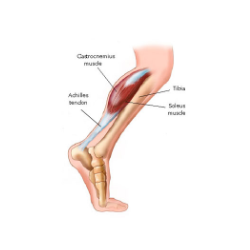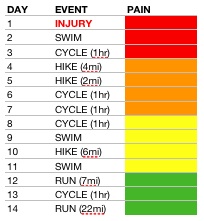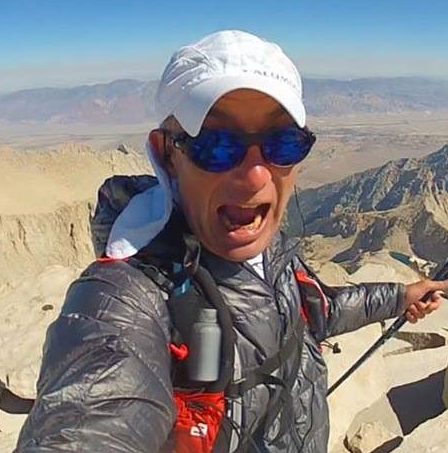
INJURY RECOVERY
I can’t remember the last time I got hurt running. I’ve been injury-free for years, the only hurt came from bike crashes. It’s easier to recover from blunt trauma than from an overuse injury. An overuse injury is a cumulative trauma disorder, tissue (or bone) damage that results from repetitive demand over time. I hurt my right calf muscle/tendon almost two weeks ago and I’ve learned a lot in the healing of such an injury recovery.
WHAT HAPPENED
I had increased my running volume, I ran a 33-mile hill course with no problem and a speedy recovery. The following week I ran a 26.2 and felt tightness in the muscles/tendons on the back of my right knee. I didn’t stretch after any of these runs. Bad boy! The day after the 26.2 I cycled for about an hour and it all seemed fine the day after that. I went on an 8 mile hill run. On my run in Griffith Park, there is this fence that I always jump over… 1..2..3.. jump! And ouch. The spring motion from the jump put too much stress on my right calf tendon/muscle juncture and it hurt a lot. A lot. I couldn’t walk and I had to call my spouse to pick me up (this never happened!).

I knew the tissues were seriously messed up, I could tell this by the nature of the pain. There are different forms of pain in endurance sports. This one was just sharp and acute, not the soreness of the day after or the heaviness at the end of a long-distance something. I estimated that it was a Grade 1 Calf Strain (or Pull) or an upper Achille’s Tendon tear or more precisely Tennis Leg (rupture between the tendon and the gastrocnemius muscle). Considering the location of the pain and the time it took to heal I think it was the Tennis Leg tear.
Tennis leg is a musculotendinous junction rupture: a stretch, tear, or complete rupture of the connection between the gastrocnemius (calf) muscle and the Achilles tendon. The injury often occurs when lunging or pushing off one leg to get to a wide ball or serve. It feels like being kicked in the leg from behind: the tennis leg sufferer feels an instantaneous severe sharp pain.
FIRST AID: p(R)I.C.E.
The pain was very sharp and I couldn’t walk on the right leg at all. Once I got home I kept on the icing (Ice is a subject of debate, while it’s useful in the short term to prevent pain and swelling it will just delay healing). Unfortunately, I had some engagements that I didn’t want to cancel and I had to go drive and have a work lunch. It doesn’t feel good to limp when you meet someone else for a work lunch! Right after that, I was able to go lay down, confirm my diagnostic and do R.I.C.E. Check out the Ankle Sprain medical presentation for more info.
R.I.C.E. stands for Rest, Ice, Compression and Elevation. Resting is important and icing the injury really helps with inflammation (or swelling but I didn’t notice any). However, icing is never recommended because inflammation plays a role. I also applied some Traumeel gel to the area. The gel (although more expensive) works better than the cream or ointment.
For compression I wore the running compression socks I’m not wearing anymore (they don’t have toes so they don’t fit in my barefoot shoes). They are stronger than the ‘recovery’ model (2XU) and it seemed to help. I also tried some Chinese herbs: Jin Gu Die Da Wan (literally “the tendon and bone injury healing” formula). This formula makes the blood circulate better and helps clear out the stagnating blood from the injury (so does the arnica montana that I took in homeopathic pellets and that Traumeel also contains). If you have high blood pressure you should probably take the other similar formula because Jin Gu really gets the blood pumping! I could feel the higher blood pressure 30 minutes after taking it, so be careful if you have high blood pressure already.
ACTIVE REST AND TIMETABLE – INJURY RECOVERY
Active rest is very important for injured athletes. If I had remained doing nothing I might have started to suffer from depression but also from a loss of general fitness and endurance. Active rest involves low-intensity training to stimulate blood flow to the muscles and tendons that have been affected. Of course, I had to modify the activities but just by removing running from the schedule (I couldn’t have run anyway, too painful). I could cycle and I could swim! Also as soon as I could walk comfortably I went to the mountains and went hiking. I was a bit limping and it was a bit painful but I felt it was important to put the injured section back in motion again.
What became also very important during the active rest period was the stretching program I designed for myself. I felt it was important to regain the full range of motion and not let the tissues scar and get short. So I stretched about 3 times a day. And as soon as I was able to go on a run I stretched before and after. I think I will have to do that for a while and it’s good practice anyway! I also read that it’s useful to use a roller to help with the scarring but I couldn’t be bothered.

As you can see on the schedule here that I was able to run after 11 days which I think is pretty good for such an injury. During the first run the area was still a bit tight. Not painful but tight. And the anxiety of having the whole muscle/tendon pop on a hill was high! I felt very happy when I realized that I could run again. I took one day off running after the first run and cycled. Then I ran 22 miles (with lots of hills). Again the area was a bit tight at first but I had a great run in 85F heat! It took me my usual time to cover the distance.
CONCLUSION
Well yes, I learned a lot being hurt. I learned that it’s foolish to push it a bit hard after over 100 miles of running in two weeks. No jumping over fences for a while. I learned to take care of an injury for maximum and speedy recovery and I learned that I should stretch before and after my runs (I was only stretching after my short runs, never after the long ones). I hope you can benefit from this experience too. Injury recovery is important.
I also learned that if I don’t run for 10 days I’m not going to go crazy!

